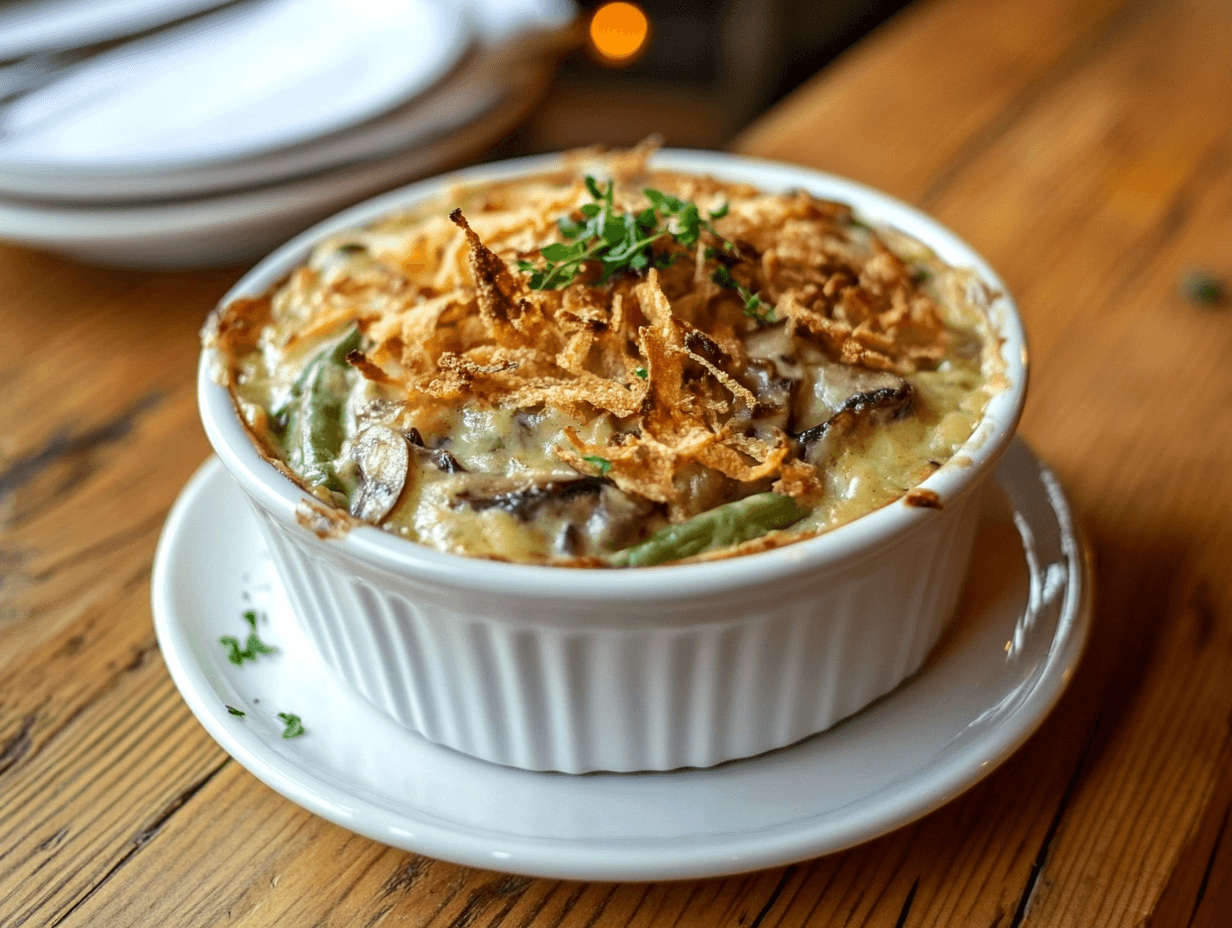Green bean casserole is a beloved dish that graces holiday tables across the United States, from Thanksgiving to Christmas. Its creamy texture, savory flavors, and crispy onion topping make it a crowd-pleaser for all ages. However, for individuals with gluten sensitivities or celiac disease, a common question arises: Does green bean casserole contain gluten? Understanding the ingredients and their sources is crucial for anyone following a gluten-free diet. Traditional recipes often rely on processed ingredients like cream of mushroom soup and fried onions, which are known to contain gluten. Thankfully, with a little creativity and the right substitutions, you can enjoy this comforting classic without compromising your dietary needs. This guide will provide you with all the details to confidently prepare a gluten-free green bean casserole, ensuring everyone at your holiday table can savor this iconic dish.
What Is Green Bean Casserole?
Green bean casserole is a popular side dish known for its creamy texture and crispy topping. It typically includes green beans, cream of mushroom soup, and fried onions. This combination creates a comforting, savory flavor that complements holiday meals.
However, the question remains: Does green bean casserole contain gluten? Traditional recipes often use processed ingredients that include gluten, such as wheat-based thickeners in the soup and flour-coated onions. While delicious, these elements can pose challenges for individuals with gluten sensitivities or celiac disease. Understanding the origins and variations of this dish can help identify where gluten might be hiding.
Understanding Gluten in Traditional Recipes
To answer the question Does green bean casserole contain gluten?, it’s essential to understand the role of gluten in traditional recipes. Gluten is a protein found in wheat, barley, and rye, and it’s often used as a thickener or binder in many processed foods.
In green bean casserole, gluten typically appears in two places:
- Cream of Mushroom Soup: Many canned varieties use wheat flour to achieve a creamy consistency.
- Fried Onions: These are usually coated in a wheat-based batter before frying.
While these ingredients enhance texture and flavor, they make the dish unsuitable for gluten-free diets. Fortunately, recognizing these sources is the first step toward creating a gluten-free version.
Breaking Down Common Ingredients

When asking Does green bean casserole contain gluten?, it’s important to analyze each component of the dish. Let’s examine the primary ingredients:
- Green Beans: Fresh, frozen, or canned green beans are naturally gluten-free. However, some canned versions may include additives, so always check the label.
- Cream of Mushroom Soup: Most canned soups contain wheat-based thickeners, making them a common source of gluten.
- Fried Onions: Commercial brands often use wheat flour in the batter, which means they are not gluten-free.
Understanding these ingredients helps clarify where gluten is typically found in this dish. Identifying alternatives for these components ensures a safe and enjoyable meal for those with gluten restrictions.
Why Does Green Bean Casserole Often Contain Gluten?
Does green bean casserole contain gluten? The answer often lies in convenience. Traditional recipes rely on pre-packaged ingredients like soup and onions, which are processed for consistency and flavor. These products often include gluten as:
- Thickening Agent: Wheat flour is a common thickener in canned soups.
- Coating: Wheat-based batter is used to give fried onions their crispy texture.
- Preservative: Some canned products include gluten-containing additives for shelf stability.
This reliance on processed ingredients makes it essential to seek gluten-free substitutes if you want to enjoy this dish without compromise.
Gluten-Free Alternatives for Green Bean Casserole
Creating a gluten-free green bean casserole begins with replacing key ingredients. Here are some simple substitutions:
- Gluten-Free Cream of Mushroom Soup: Brands like Pacific Foods and Imagine offer gluten-free options, or you can make your own using cornstarch or gluten-free flour.
- Gluten-Free Fried Onions: Health food stores often carry gluten-free fried onions, or you can make them at home using gluten-free breadcrumbs.
- Alternative Thickeners: Use tapioca starch, arrowroot powder, or rice flour to achieve a creamy consistency without gluten.
These substitutions maintain the flavor and texture of the original dish while ensuring it’s gluten-free. For added variety, consider pairing your casserole with healthy and tasty substitutes for oil in brownies for a balanced meal.
Step-by-Step Guide to Making Gluten-Free Green Bean Casserole

Follow this step-by-step process to prepare a gluten-free green bean casserole:
Ingredients
- Fresh or frozen green beans
- Gluten-free cream of mushroom soup
- Homemade or store-bought gluten-free fried onions
- Milk or a non-dairy alternative
- Garlic, pepper, and herbs for seasoning
Instructions
- Prepare the Green Beans: Blanch fresh green beans or rinse canned ones to reduce salt.
- Make the Sauce: Combine gluten-free cream of mushroom soup with milk or a dairy-free alternative. Add seasoning for extra flavor.
- Assemble the Casserole: Layer green beans, sauce, and gluten-free fried onions in a baking dish.
- Bake: Cook at 350°F until the sauce is bubbling and the topping is crispy.
This method ensures the dish is both gluten-free and delicious.
For additional festive ideas, explore recipes like banana brownie recipes to round out your holiday spread.
How to Identify Gluten-Free Products
When shopping for ingredients, it’s crucial to ensure they are truly gluten-free. Here’s how to identify safe options:
- Read Labels Carefully: Look for certified gluten-free symbols or ingredients like cornstarch instead of wheat flour.
- Avoid Cross-Contamination: Check that products are processed in gluten-free facilities.
- Trusted Brands: Opt for well-known brands that cater to gluten-free diets, such as Pacific Foods or Bob’s Red Mill.
Being vigilant about product labels minimizes the risk of consuming hidden gluten.
Why Should You Choose Gluten-Free Alternatives?
Choosing gluten-free alternatives benefits not only those with gluten sensitivities but also anyone seeking a healthier option. Here’s why:
- Health Benefits: Avoiding gluten reduces digestive discomfort for those with celiac disease or gluten intolerance.
- Inclusivity: Gluten-free recipes ensure everyone at your table can enjoy the meal.
- Customization: Using homemade substitutes allows greater control over flavor and ingredients.
These advantages make gluten-free options a thoughtful and practical choice.
Additional Tips for Making Gluten-Free Green Bean Casserole
To elevate your gluten-free casserole, consider these tips:
- Add Fresh Herbs: Incorporate thyme, parsley, or rosemary for a burst of flavor.
- Try New Toppings: Experiment with crushed nuts, gluten-free breadcrumbs, or even shredded cheese for added texture.
- Use Non-Dairy Alternatives: If lactose is a concern, substitute almond milk or coconut cream in the sauce.
These enhancements add depth and variety to your dish.
Conclusion: Enjoying Green Bean Casserole Worry-Free
In conclusion, the question Does green bean casserole contain gluten? has a straightforward answer: it often does in traditional recipes due to the inclusion of wheat-based ingredients. However, this doesn’t mean you need to miss out on enjoying this cherished holiday staple. By making thoughtful substitutions, such as using gluten-free cream of mushroom soup and fried onions, you can recreate the dish in a way that is safe and delicious for everyone. The beauty of green bean casserole lies in its versatility, allowing you to tailor the recipe to suit various dietary needs while retaining its signature flavors. Whether you’re hosting a festive gathering or preparing a casual family dinner, a gluten-free version of this dish ensures inclusivity and culinary satisfaction. With the tips and alternatives shared here, you can confidently serve a green bean casserole that everyone will love, worry-free.
FAQs
Is there gluten in green beans?
No, green beans are naturally gluten-free. They are safe for those with celiac disease or gluten sensitivity as long as they are not processed or mixed with gluten-containing additives. Be cautious when using canned green beans, as some brands may include preservatives or seasonings that contain gluten. Always check the label to ensure they are free from gluten.
What is green bean casserole made of?
Traditional green bean casserole consists of three main ingredients:
Green beans: Fresh, frozen, or canned.
Cream of mushroom soup: Typically used for its creamy texture and flavor.
Crispy fried onions: Added as a crunchy topping.
Additional seasonings like garlic, pepper, and salt may be included. Gluten-free versions replace the soup and onions with alternatives that do not contain gluten.
What foodborne illness can you get from green bean casserole?
Improperly handled or stored green bean casserole may pose a risk for foodborne illnesses like salmonella or listeria, especially if it contains dairy-based ingredients or if it’s left at room temperature for too long. To minimize risks:
Refrigerate leftovers promptly (within 2 hours).
Heat the casserole to an internal temperature of 165°F (74°C) to kill harmful bacteria.
Use fresh, high-quality ingredients to reduce contamination risk.
Why is my green bean casserole bland?
A bland green bean casserole is often due to insufficient seasoning or low-quality ingredients. To enhance the flavor:
Add fresh herbs like thyme or parsley.
Include spices such as garlic powder, onion powder, or smoked paprika.
Use a rich cream of mushroom soup and freshly fried onions for more depth.
Taste the components as you prepare them to ensure a balanced and flavorful dish.
Is green bean casserole better with canned or fresh?
The choice between canned and fresh green beans depends on personal preference:
Canned Green Beans: Convenient and soft, making them a classic choice for traditional casseroles. However, they may contain added sodium.
Fresh Green Beans: Provide a firmer texture and a fresher taste. Blanching them before use ensures they cook evenly and retain a vibrant color.
For a more flavorful dish, fresh green beans are generally preferred, but canned options work well for convenience.


2 thoughts on “Does Green Bean Casserole Contain Gluten?”